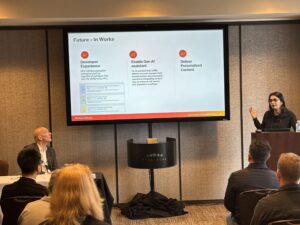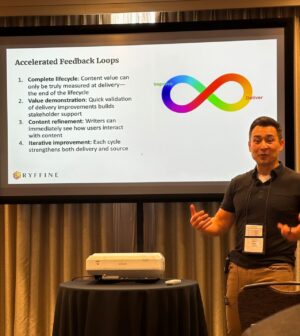While the high potential and benefits of AI are no longer in question, many organizations are still grappling with how to launch new AI projects and how to prepare their content for future changes and technologies. Throughout the presentations at ConVEx 2025, speakers continuously relayed the same message: AI models are only as powerful as the content behind them, so focusing on goals like content quality, findability, and structure are the keys to success in the face of change.
Read on to discover the top ConVEx takeaways from Fabrice Lacroix, David Riggins, and Mike Hovan, who were onsite, exchanging bold ideas, and ready to dive into the future of content.

Why Tech Changes Fast,
but Great Content Lasts
At the beginning of the event, Dana Aubin, Senior Consultant from Comtech Services, reinforced the mindset that the successful adoption of new tools relies on fundamental best documentation practices. She stated that “the top topic this year at ConVEx is AI, as usual, because that’s what’s on all of our minds. But we have to remember that AI is fueled by good content. So, all of the things that we’ve learned over the years are still valid. We still need good taxonomies, we still need good content, we still need structured content. So don’t forget the basics when you get excited about AI.”
Rob Hanna from Precision Content Authoring Solutions further echoed this sentiment during his presentation “Preparing for AI: Are We Ready for What’s Next?” when he recommended teams focus on building a corpus of high-quality content to feed their AI content projects.
Hanna explained how many companies struggle to build Generative AI (GenAI) systems that produce extremely accurate and consistent responses. Specifically, he discussed the tremendous challenge in going from 90% to 100% accuracy – or “last 10%.” Covering this final 10% represents a huge leap in difficulty and it rests largely upon the quality of your content and not on the AI tools you are using
Overall, ConVEx attendees were like-minded, with presentations largely focused on how to navigate change and future-proof content to prepare for AI or other new tools. With that overarching theme in mind, here are three event takeaways for how to successfully navigate a shifting content environment.
1. Lead with People and Empathy for
Successful Transformation
People know that AI tools offer a wide array of benefits, but do these perks outweigh the challenges faced along the way? A new report from Writer reveals that two-thirds of C-suite executives say the process of adopting GenAI tools has created tension or division within their companies. What’s more, 42% go as far to say that the process is tearing apart their organization.
Change is hard and it’s not a simple technical problem that can be fixed with the right code. Changing how people work requires just that – people. Centering the needs and voices of your teams is the way to lead positive change management. As Val Swisher and Leslie Farinella from Content Rules explained in their presentation “Bridges Not Barriers: Reaching Across Silos”, even the most well-designed systems need intentional governance and collaborative, cross-functional relationships to build sustainable results. After all, creating partnerships across silos between various teams will not only facilitate progress towards new tools and ways of working, but also reduce the costs and resources needed to build capabilities for AI or other emerging technologies.
The first step is to understand how teams work currently: what tools they use, what their workflows look like, and how they feel about their processes. Then, coming from a place of true collaboration, leaders can work with teams to drive change. DITA Strategies’ Amber Swope and Intuitive Stack’s Dan Schommer summed it up perfectly in their presentation “Love Your Agent of Change: Embracing Your Partner in Transformation”. There, they stated that anyone who wants to be an Agent of Change must lead with empathy to successfully navigate and leverage new opportunities.
2. Get Back to Content Basics for
Future-Proof Documentation
Change is inevitable, and it’s clear that reinforcing good content practices is the solution to a seamless adoption of new technologies or tools.
In their presentation “Hitachi Vantara’s Journey to Next-Level Content Experience”, Hitachi Vantara’s Jyoti Ramchandra and Fluid Topics’ Fabrice Lacroix explored how design thinking can be used to create a roadmap for optimizing content for new tools. Jyoti’s team used this process to implement an intuitive documentation portal for highly personalized user experiences amidst a growing product portfolio. In the presentation, she highlighted five essential ways to optimize content before launching new tools.
- Start and end with content: It’s important to start the process by identifying data sources and content that is usable, relevant, and actively used. This is also the moment to define documentation retention.
- Make it easy for users to search for content: To create a search-friendly experience, companies can implement a faceted taxonomy to allow users to refine their search results.
- Define and align your taxonomy with the company’s brand: Teams should tag content according to metadata like product, version, and context to make relevant content easier to find. Then, they can create controlled vocabulary and synonym lists to improve search results.
- Provide personalized content for each user’s context: Teams provide seamless user experiences by only providing users with the information that’s relevant to their specific needs and situation. Remove excess information and content duplication.
- Design a user-centric site: The final step is to build a content portal that focuses on simplicity, intuitive navigation, and consistent user experiences across all devices, while also considering accessibility and compliance.
Hitachi Vantara chose Fluid Topics as their flexible, future-proof Content Delivery Platform. By first optimizing their content quality and delivery, any GenAI tools that Hitachi Vantara implements will seamlessly leverage the full potential of their content, simplifying future AI projects.
Ryffine’s Frank Miller also spoke about getting back to content basics in his presentation “Structure Through Delivery: The New Gateway to DITA Adoption”. There, he emphasized the importance of foundational technical writing practices like structured writing, metadata, and semantic text enhancements in the face of integrating new technologies.
Miller also recommended the quick win of starting the content optimization process by investing in a Content Delivery “Portal”. He suggested this as these tools centralize mixed content types to allow companies without structured content to gradually migrate documentation in a more strategic, secure, and cost-effective way. A key benefit to this delivery-first approach is that it allows teams to advance in their AI projects and content restructuring operations in parallel.
3. Be Open to Evolutions in Team Structure and Strategy
Whenever we leverage new tools, we must stay flexible and adjust as we go. Pegasystems’ Brandon Lamontagne explained how restructuring their content team has allowed them to smoothly evolve with the ebbs and flows of trends and technologies in his presentation “Navigating Content Strategy in an Evolving Digital Landscape”.
Pegasystems navigates high level strategic content changes thanks to their Content Engineering team. These Content Strategists (like Lamontagne) work with over 50 technical writers, overseeing the company’s strategies, pinpointing bottlenecks and inefficiencies, and playing a central role in implementing new technologies.
“Content strategists are no longer a luxury … they are a necessity.”
Brandon Lamontagne, Pegasystems
By changing the team’s structure, Pegasystems was able to successfully implement new AI projects. In addition to these high-level management practices, Lamontagne shared five concrete content takeaways his team found to be essential when navigating shifting strategies.
- Test all tools, UX, and enhancements: Strategists must evaluate and drive the adoption of new content tools and processes, beta test features, collaborate with authors, and drive documentation initiatives (such as subway maps).
- Focus on training technical writers: Once a new tool is in place, the next step is to educate writers on how to use the new tools, how the tools figure into workflows, and where to go for help with using their features.
- Provide content operations support: While overseeing the full documentation workflow, the content engineering team should look for opportunities to merge GIT branches, solve merge conflicts, enforce standards and best practices (such as SEO), manage information delivery processes, and provide authoring and tool support.
- Track site analytics: Once the tools are up and running, strategists should continue to analyze site data to gauge performance and user engagement. They should also provide these analytics to organizational stakeholders, identify areas of improvement, and track successes.
- Standardize the writing process: The content engineering team should conclude all strategy shifts by jotting down all newly available document tools, authoring standards, and procedures in their Tech Doc Guidebook.
Introducing the content strategists into the team allowed them to gain a high-level look at where to improve their authoring practices, creating a more flexible, enduring strategy. These tips are beneficial for future-proofing workflows when integrating any new tools and technologies.
Looking Forward to ConVEx 2026!
Change is hard, but navigating it well leads to big rewards. ConVEx 2025 provided concrete insights into how to introduce new tools and technologies while keeping quality content at the core of your work. With these practices in mind, teams will be more flexible and resilient in the face of future changes.
We can’t wait for more great insights at next year’s event! Until then, don’t miss our list of 2025 must-attend events for more great conversations and presentations.
Latest post








